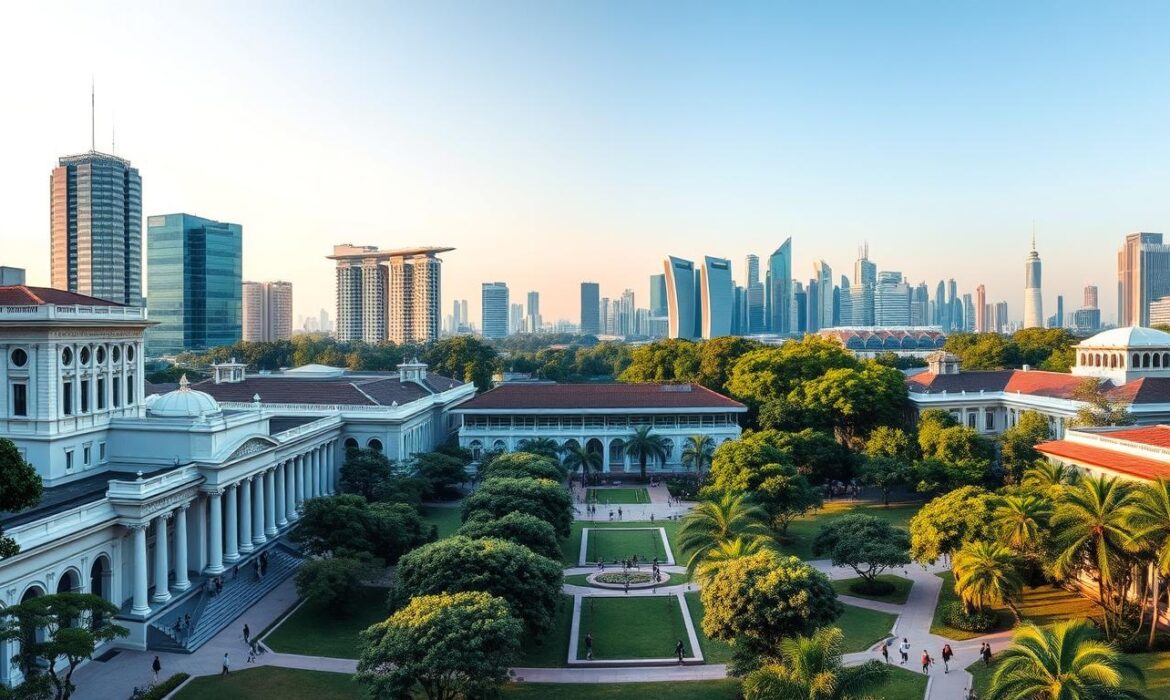Singapore stands out as a leading education hub with world-class institutions. Two of its universities rank in the THE World Top 50, attracting students from across the globe. The National University of Singapore (NUS) and Nanyang Technological University (NTU) offer cutting-edge programs with strong industry connections.
This island nation blends innovation with cultural diversity. Chinese, Malay, Indian, and Eurasian communities create a vibrant learning environment. Students gain exposure to multiple languages and business networks throughout Asia.
Government initiatives support graduate entrepreneurship, making it ideal for startup-minded learners. Compared to Western countries, tuition and living costs remain competitive while maintaining high academic standards.
Key Takeaways
- Singapore hosts two top-50 global universities (NUS #19, NTU #32)
- Multicultural environment enhances language and cultural learning
- Strong government backing for research and graduate startups
- More affordable than many Western education destinations
- Gateway to career opportunities across Asia
Why Study in Singapore?
Global learners seek Singapore for its dynamic blend of innovation and tradition. The country’s higher education system ranks #1 in PISA tests, ensuring top-tier learning standards. With costs 30% lower than the US or UK, it’s a smart choice for budget-conscious international students.
Career opportunities abound. Over 63% of NTU graduates secure jobs within six months of graduation. The government supports this with a 3-year post-study work visa for subsidized tuition recipients. Companies like JP Morgan and Seagate actively recruit from local campuses.
- Affordable living: Average monthly costs ($1,475) beat Western alternatives.
- Global network: NUS hosts students from 100+ nationalities.
- Specialized programs: Yale-NUS College and Duke-NUS Medical School offer unique paths in medicine and social sciences.
South Asian students benefit from cultural familiarity and proximity to home. English as the primary language removes barriers. For hands-on learning, explore industry-linked projects that connect classroom theory to real-world engineering challenges.
Seven libraries with 1.5 million titles fuel research excellence. Whether in business or tech, Singapore’s universities prepare students for the global stage.
Top Universities in Singapore
Singapore’s higher education landscape features globally ranked institutions with diverse programs. These schools excel in research, engineering, and business, drawing students from over 100 countries.

National University of Singapore (NUS)
Founded in 1905, NUS ranks #8 in the THE World University Rankings. It offers 370+ degrees across 16 faculties, including top-tier medicine and environmental science programs. With a 5–15% acceptance rate, it’s highly selective.
Nanyang Technological University (NTU)
NTU’s sprawling 2km² campus includes Olympic Village-style dorms. Known for engineering and tech, it partners with Imperial College London. Over 24,000 students benefit from its 7 research fields.
Singapore Management University (SMU)
Modeled after the Wharton School, SMU focuses on business and social sciences. Its 20–30% acceptance rate reflects its competitive edge. Tuition averages $25K–$27K for specialized courses.
Singapore University of Technology and Design (SUTD)
SUTD’s collaboration with MIT offers accelerated 3.5-year programs. Its mandatory design thinking curriculum prepares graduates for tech-driven careers. Ranked 369th globally, it’s a rising star.
Singapore Institute of Technology (SIT)
SIT bridges polytechnic and university education, with tuition ranging from $22K–$34K. It emphasizes hands-on engineering training and boasts a 15–20% acceptance rate.
What Makes These Universities the Best?
Global rankings consistently highlight these institutions for their innovation-driven curricula and world-class faculty. The Times Higher Education (THE) framework evaluates schools on research reputation, citations, and industry partnerships—areas where Singapore excels.

NUS leads with 25% of the nation’s research output and three Nobel Laureates, including physicist Konstantin Novoselov. Its 1.5 million library resources support groundbreaking work in medicine and environmental science.
NTU’s 5,000 staff members represent 79 countries, fostering a global perspective. Seven research fields—from AI to sustainable development—attract top talent. Meanwhile, SUTD tops QS metrics for citations per faculty, proving its impact.
SMU stands out with 350 industry-expert instructors and 30+ specialized institutes. Corporate training programs bridge academia and business. At SUTD, every student completes mandatory entrepreneurship courses, preparing them for tech leadership.
These schools don’t just teach—they shape futures. Two Singaporean prime ministers graduated from NUS, reflecting its leadership legacy. Whether through SIT’s hands-on labs or NTU’s Olympic Village dorms, each institution offers unique advantages.
Choosing the Right University for You
Selecting the ideal university requires careful consideration of academic goals and personal preferences. Each institution offers unique strengths, from NUS’s global exchange programs to SIT’s guaranteed industry placements.

Start by comparing program structures. SUTD’s accelerated 3.5-year courses appeal to those eager to enter the workforce faster, while traditional 4-year programs allow deeper science exploration.
Admission competitiveness varies significantly. NTU maintains a 10-20% acceptance rate, while Yale-NUS College selects only 3.2% of applicants. SMU’s MBA program requires GMAT scores above 600.
Here’s a quick comparison checklist:
- Costs: NUS ($30K-$153K) vs SIT ($22K-$34K)
- Specializations: SMU for finance, SUTD for architecture
- Language: IELTS 6.5 minimum for international students
- Outcomes: 63% of NTU graduates secure jobs before graduation
Prospective students should attend NUS Open House events or schedule campus tours. Seeing facilities firsthand helps assess learning environments for engineering or business studies.
Remember, the right choice balances academic rigor with career preparation. NTU’s UK-modeled medical school might suit future doctors, while SMU’s corporate connections benefit finance aspirants.
Conclusion
With a 94% satisfaction rate, students thrive in Singapore’s academic environment. The unique East-West blend fosters innovation, while post-graduation perks like a 3-year work visa boost career prospects.
Indian students are increasingly choosing Singapore, with applications rising 15% yearly. Graduates from national university programs often launch startups or earn salaries 20% above average.
Apply early due to competitive admissions. Pair studies with language immersion or exchange programs through world-class partnerships. Singapore’s rankings and research strengths make it a smart investment for global learners.



